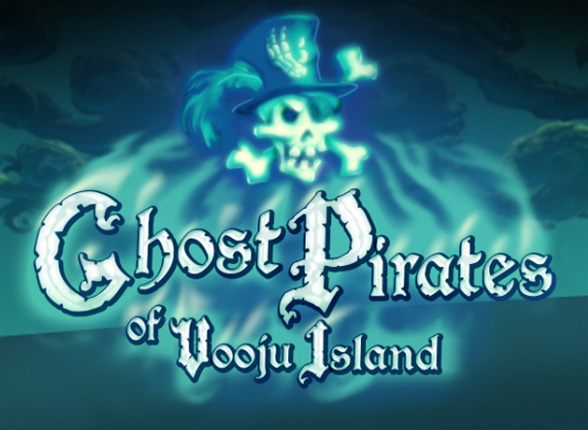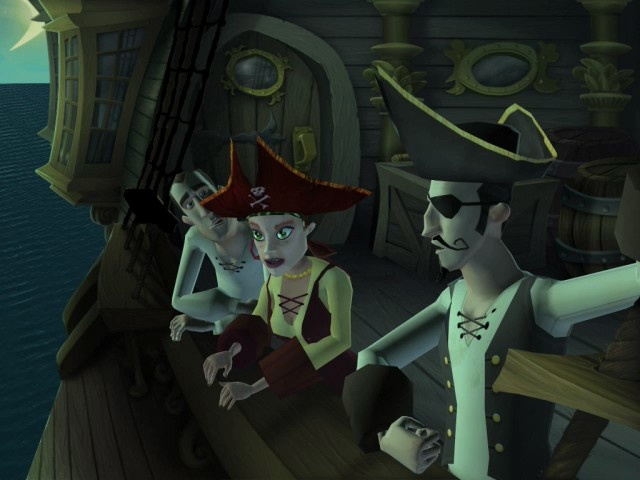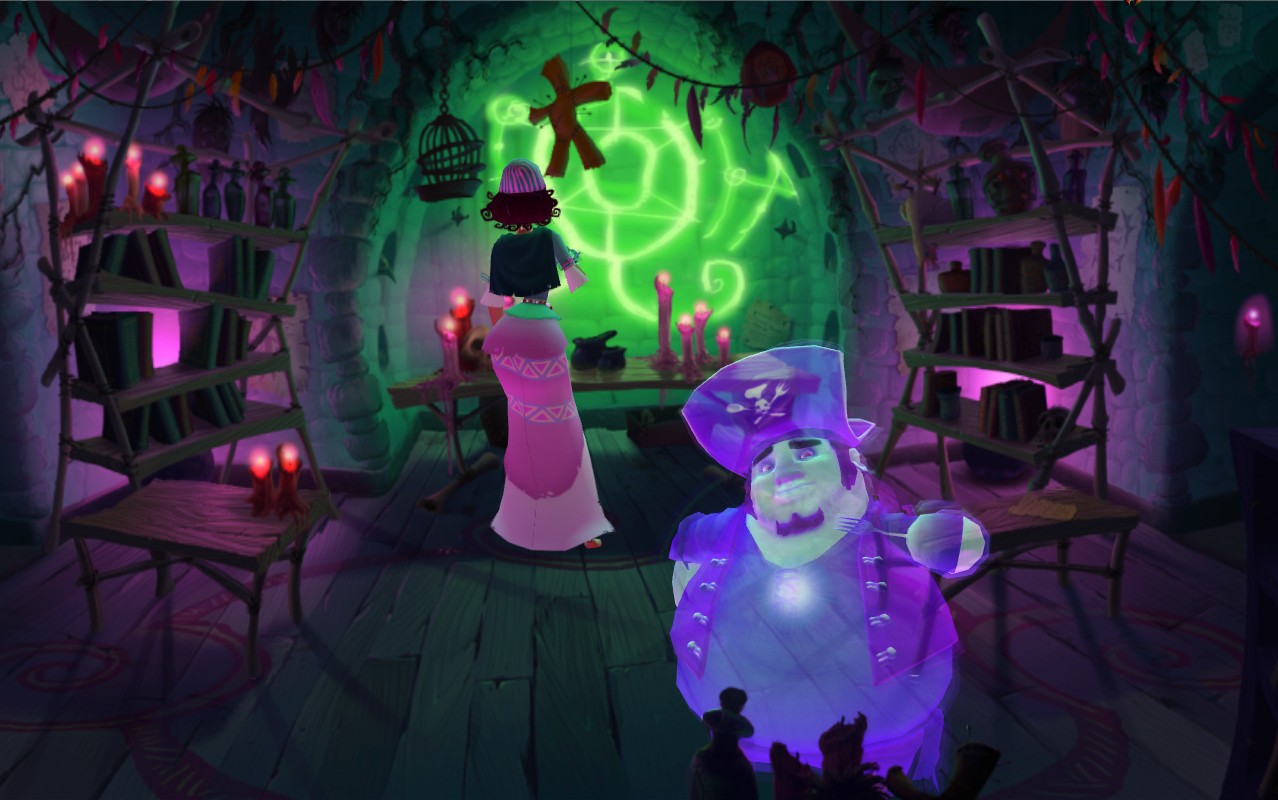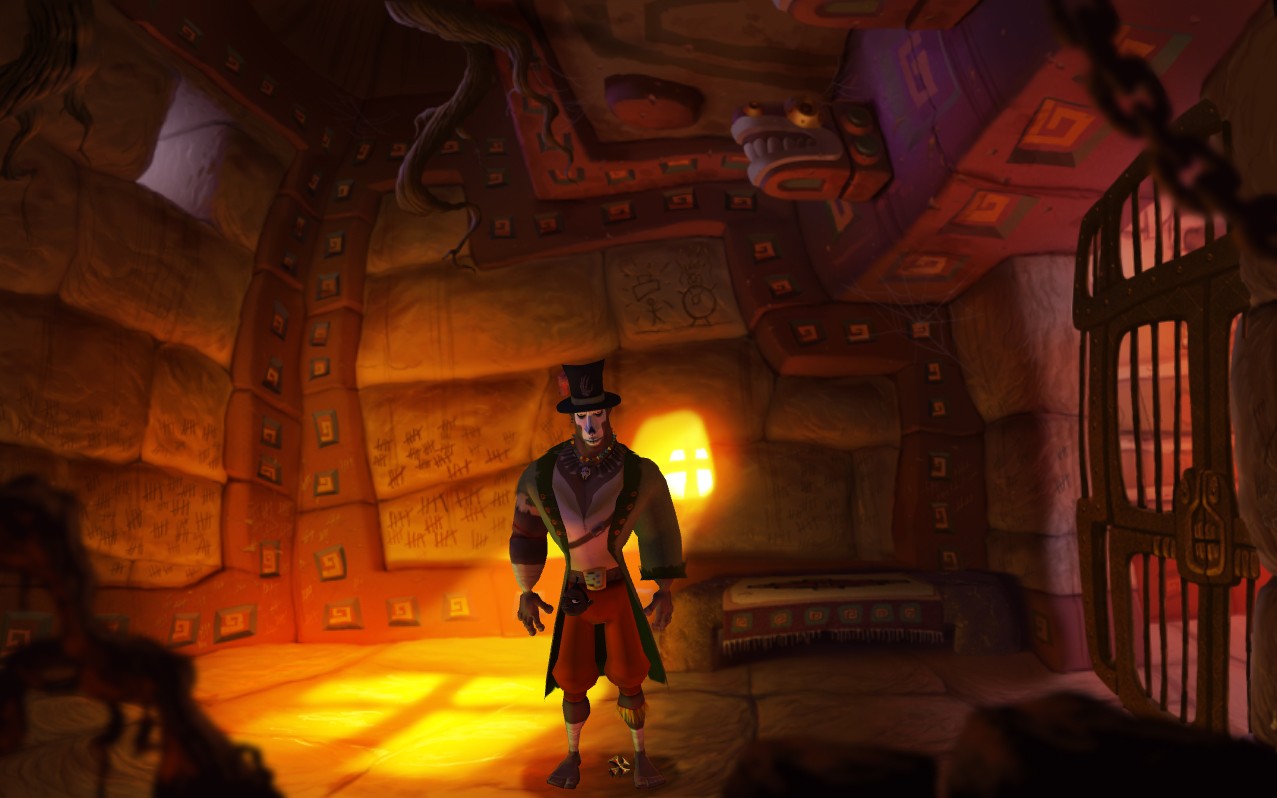Articles

Ghost Pirates of Vooju Island Page One

Because I guess the word “voodoo” is trademarked?
Ghost Pirates of Vooju Island is a game riddled with the evidence of extreme duress of time and budget, but the evidence of the development team’s passion and talent under those conditions overwhelms it. With its second game, a production sandwiched between the first two installments of the A Vampyre Story saga, Autumn Moon continues its mission to find a way to make graphic adventures with the production values (read: luscious, hand-illustrated backgrounds) of yesteryear within the confines of real world parameters. Like A Vampyre Story, Ghost Pirates isn’t able to accomplish this without being pretty rough around the edges, but it is nonetheless successful, a feat due largely to the order its priorities are sorted on.
It’s tempting to look at screenshots and the credits of Ghost Pirates and conclude that the game owes its existence to the Monkey Island series, and even that it’s trying to capitalize on the recent Tales of Monkey Island. To play the game, however, is to have any notion of “ripoff” immediately dispelled, and will make the fact that its production actually came before TMI’s easy to believe. While Bill Tiller may be revisiting that same supernatural pirate-y sector of his inner self he’d previously tapped on CMI, and “Monkey Island” were no doubt the two most helpful words to be able to toss around during the pitch meeting, Ghost Pirates is a legitimately self-contained creation whose universe is fully formed and distinct from that of Guybrush’s adventures, however winkingly conscious it might be of them.

The story is set in the Azurbbean Sea, a fictional version of the Caribbean that is called home by pirates, Mesoamerican-esque tribes, voodoo practitioners, and eldritch creatures. Despite this diversity, the inhabitants of the various islands live in relative harmony under the protection of Captain Tiberius Flint, the noble pirate king. Not everyone is satisfied under Flint’s rule, however - Captain Greenbeard, a longtime subordinate, orchestrates a plot against the king with a crew of fellow mutineers. As the curtain rises, Greenbeard's ship is moored off of the mysterious Vooju Island, where lives Papa Doc Mystère and a number of dark secrets. A respectful and formidable wielder of the sacred, mystical art of voodoo (or “vooju,” as the game calls it), the retired Papa Doc splits his time serving as the protector of the island's vooju temple and running a coconut plantation with his young wife, Queen Zimbi.
A series of developments, escapes and double-crosses later, Papa Doc suddenly finds his fate entwined with those of two unlikely cohorts - Captain Jane Starling, a daring swashbuckler and chief spy for Flint who carries something of a torch for him, and Blue Belly, a bumbling and likeable cook who reluctantly joined Greenbeard’s crew to fund his little sister’s corrective dental work back home on Merry Cay. Almost immediately after the three meet they are cursed by the perfidious Mimbi, who reveals her alliance with Greenbeard. Her intention is to end a wrathful vooju deity’s term of dormancy beneath the island’s volcano, and to help her achieve this goal she is amassing a zombie army using Greenbeard’s recruits.
Papa Doc proves quick to react, however, and is able to cast a spell over himself and the others that keeps them in a state of “half-dead,” a ghostly form they’ll be free to take on even after they manage to retrieve their separated bodies. As spirits, the trio have newfound abilities and limitations – a psychic connection allows them to communicate at all times as well as see, hear, and even act through each other, but they are unable to be sensed by the mortal living and are subject to conventional ghost repellents such as salt and chicken blood.

With this premise the game puts you in control of all three heroes with the freedom to toggle between them at any time. While this naturally will call to mind such games as Day of the Tentacle and Bone: The Great Cow Race, a key difference in the approach taken by Ghost Pirates is the fact that each character’s independent segment can be completed without a switch, which is handled via clicking a character icon in your inventory (and which is the only real change in the interface carried over from AVS). Collaboration between the playable protagonists, which is an integral aspect of the gameplay, is accomplished entirely through their supernatural connection. As each character is equipped with different areas of expertise - Papa Doc might have some light to shed on anything vooju-related, Starling knows a thing or two about romance and ingenuity, and Blue Belly can reveal a previously unforeseen purpose for a cooking ingredient – many of the puzzles involve showing inventory items to your physically separated but omnipresent allies in order to gain new insight into their possible uses. This concept is executed very well, with the designers exploiting each character’s personality as much as their environment in coming up with puzzle scenarios. The key strength of Ghost Pirates is its reliance on its characters, using them as the constant focal point.
The puzzles are inventive and fun, and for my money superior overall to those of A Vampyre Story. Due partially to the way it is structured, the game strikes, I found, a very agreeable balance with its difficulty, which is just stiff enough to keep things from feeling condescending yet at the same time not quite frustrating enough to make you quit - at least not permanently. While each character’s individual missions are adequately sized, the number of locations and items they’re limited to make the goals always seem reachable, a reassurance I felt even when I wasn’t sure what to do next or couldn’t quite wrap my head around the sometimes wonky brand of logic. The game reprises the concept of “idea” inventory items from AVS, and it’s taken even further here (it’s rare for your character to physically add an item to their collection) and is better handled as well - the tedious sequences showing the character retrieving an item when the time comes to use it have been dropped. To be sure, there are a couple of misguided puzzles encountered, most notably a charades type bit with Blue Belly that is a prime example of good concept, botched execution, but overall I was quite pleased to find the puzzle design of the highly traditional Ghost Pirates to be just right for my tastes.

Being that there’s no accounting for it, your tastes may or may not converge with the game’s sense of humor, which is definitely as heavy a presence as you’d expect given the genre and the people involved. Personally, I never found myself laughing very much at the game’s constant attempts to be funny, but neither was I put off by it, recognizing the jokiness and generally lighthearted nature of the adventure (which, like with Monkey Island, is contrasted with themes and situations that are pretty dark) as an important part of the game’s overall charm. I am reminded that classic Disney movies, which are some of my favorite films of all time, seem celebrated for their moments of cheese rather than in spite of them. Perhaps more important than it being guffaw-inducing, the humor, like the puzzles, is consistent and character-specific, the latter being something I especially appreciated. Papa Doc’s chauvinism, for example, is entirely relevant to the story even if it didn’t make me double over with laugher in the instances where it clashes with Starling’s roguish independence. Happily, Autumn Moon has also addressed an issue I and others felt hurt A Vampyre Story, which was the tendency for its dialogue to be overwritten.